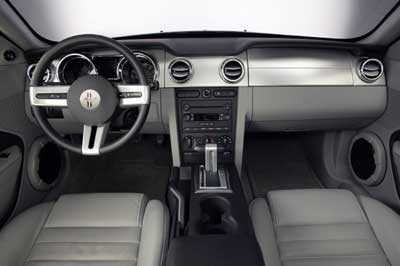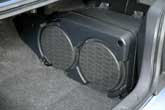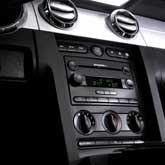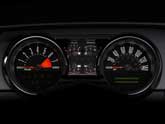Recent Articles
Popular Makes
Body Types
2005 Ford Mustang Interior
Ride, Sally Ride

SANTA MONICA, CA -- Morning light glistened off the Pacific Ocean as I climbed down onto the Santa Monica boardwalk for a morning walk along the beach. As an artists’ community such as Santa Monica, I had plenty of company, but three people stood out from the eclectic crowd. They were holdovers. And from the Sixties as well. One wore a tie-dyed T-shirt, with silver hair collected into a braid down his back. The tin sound of a Beatles song escaped his small transistor radio, and he rode a wide-handled cruiser with a wicker basket in the front. The other two were clearly a couple, dressed alike with broad-brimmed straw hats (hers accented with a ribbon) and Nehru-style shirts over faded blue jeans. They were each capturing their own view, with easels set up on the Santa Monica Pier. He was painting the scene to the north. She preferred the light to the south. Holdovers at the beach, I thought. How typical. I wondered if the new 2005 Ford Mustang was also a holdover from the sixties. Not likely. And, as it turns out, not at all. In fact, there is a marked difference between the previous generation Mustang, and the Mustangs of the sixties, those most commonly thought to provide the inspiration for the 2005 model. Yes, the 2005 Ford Mustang is retro: inside and out. But it’s also refreshingly modern, especially when it comes to the interior. There is a dramatic and way-cool difference in a cockpit that becomes your home-away-from-home (or as Ford will suggest in a new ad campaign--your Field of Dreams) when you get into the 2005 model. The experience reminded me of last year, when Ford Motor Company introduced the all-new F-150 pickup truck. Among the truck’s attributes, its interior execution stood out as particularly impressive. All across the lineup, from the base XL model to the fully refined Lariat, the cockpit seemed car-like in its layout, precision, and in some cases, luxuriousness. One question that was asked then was – why can’t Ford’s car interiors look this good?
Page 2: Nineties
For 2005, the question of interior quality is answered. They can. The interiors of a number of new models are not simply upgraded, but they look great. And perhaps the most exciting showcase of all is the new design method used in The Blue Oval’s sports car icon of the past 40 years.Scrapping the nineties The last generation Mustang interior was dominated by free flowing, curving lines and shapes that either intersected with one another, or were juxtaposed to create some sort of subtle, perhaps even “futuristic,” tension. At a glance, space was not always clearly defined, particularly in the doors where the lever, pocket, and speaker grille all hovered in the bottom front corner. These components visually interacted with one another, but the correspondence was unclear, and may have existed simply because of proximity. The former dash suffered as well, as the U-shaped center console morphed into the instrument cluster and passenger-side panel. While there is nothing inherently wrong with this design, the placement of rectangular vents, especially the single one on the passenger side, polluted the interior with afterthoughts. Space was not only vague, but it also was used somewhat poorly. Finally, the choice of materials left a lot to be desired, as gray and black plastic signaled poor quality or tackiness and, for the emotional, automotive enthusiast crowd, dreariness. Extensive reworking of the ’05 interior has yielded a much cleaner and more refined style. Interestingly, Ford turned to a previous design to create this modern look – the inside of the new Pony car is based on the layout of the old 67-68 Mustangs. In constructing the cabin, however, design engineers assured a contemporary look (as well as cost savings) by borrowing several pieces from the new F150.

Page 3: Throwback
First a look at the 60s-inspired details. The large circular speedometer and tachometer are the most prominent “old school” features, as they directly reference the instrument cluster of a 1967 or 1968 Mustang. These chrome-bezeled, barrel-like gauges are symmetrical in placement and employ the same numerical text as the old version. Instead of using three additional smaller gauges to communicate vitals such as engine temperature, fuel level, and oil pressure, Ford designers cluster the auxiliary bunch neatly between the two large units. But the coolest feature is the lighting – for the first time Ford offers a color-configurable cluster that can display more than 125 different colors thanks to LED technology. Classic Mustangs used a dim green, which can be matched if desired. Directly in front of the instrument cluster, the three-spoke steering wheel is derived from the 1967 “prototype.” The previous generation’s wheel was positioned at a slight angle, whereas the new sits square on-center and provides great ergonomics. A black center hub with a horse and stripes logo emulates the original; a nice job adapting a previously-used design to meet modern safety standards. In the 60s, some GT model Mustangs came adorned with aluminum trim across the entire dash. Today, collectors pay big dollars for these original pieces. Once again, Ford offers real aluminum panels as part of an available appearance package. The strips are horizontally ribbed, providing accents both visually and tactilely.

Page 4: Contemporary
In order to modernize the new Mustang’s interior, the F150’s parts bin was raided. The all-new circular vents that are flush-mounted in the F150’s dash protrude from the Mustang’s board, as well, and can be highlighted with available chrome bezel rings. The in-dash CD player and display is the same unit used in all F150s, except the Lariat version and the three manual HVAC control knobs below the audio center are also replicas from the truck. (This layout is a departure from that of the former version, which placed these knobs above the stereo.)Some Ford F150s arrive with a center console attached to the dashboard, and it is from this element that the Mustang’s console is based. Upright, square-arched “eyebrows” on both sides of the center stack help the direction of the design progress from vertical to horizontal. On the door panels, the inside levers are now mounted at the top, also emulating the placement and look of those in the F150, and no longer contribute to a mass of confusing space. Either a short-throw five-speed shifter or a T-handled automatic lever is positioned at the front of the console, a cue true to classic Pony cars. Choice of materials and Standard equipment Base Mustangs feature supportive cloth seats with horizontal ribbing that references the 60s. Leather surfacing and six-way power adjustment is optional. Choose a GT model, however, and a Color Accent Package that includes red leather seating surfaces, red door inserts, and red floor mats becomes available. An overhead console provides storage, as does the space between the front seats. Two cup holders and two power outlets are standard.

Page 5: Space
All new models arrive with power windows that include both driver and passenger “one-touch” up and down operation. The windows can also be raised remotely by turning and holding the key in the lock. Speed control, keyless entry, power mirrors, a heated rear window, and interval wipers are all standard. The base stereo system pushes 80 watts through four speakers, after reading a single CD. A six-disc changer, door- and trunk-mounted subwoofers, and power up to 1,000 watts are available. Dual front airbags are standard, and seat-mounted side-impact units are optional.Space matters Mustangs have always been a little tight, particularly in the back seats. For 2005, Ford increases rear legroom by 1.1 inches and rear shoulder room by 1.2.-not much, yet noticeable when taking a turn in the back, letting a colleague take over the reins. Up front, headroom has increased by half an inch while shoulder space grows by 1.8 inches. Despite the complaints by some larger drivers, designers did not want to compromise the “cockpit” feel associated with Pony cars. For 2005, Ford has married the design elements, both classic and contemporary, that are most worthy of praise. By thoughtfully combining them, the whole is greater than the sum of the parts. The Beatles, the Beach Boys and Mustang Sally would all like this new pony.

Page 6: FAQs
What kind of gas mileage can we expect from the 2005 Ford Mustang? The GT is rated a 17/25 city/Hwy, and the V6 is rated 19/28. Expect worse, however, as most people will be mashing the pedal more often than the MPG estimates. What’s the best thing about the 2005 Ford Mustang? The exterior design, followed by its performance on the road. The new underpinnings – especially the work done to the rear live axle – make this a much better car. What’s the worst thing about the 2005 Ford Mustang? The interior materials. Ford could have hit a grand slam, but things such as the headliner material and differences in plastics were subpar.

Page 7: Notes
2005 Ford Mustang specifications: Base price: $19,410 (V6); $24,995 (V8) Engine: 4-liter V6 (210 hp @5,250 rpm, 240 lb.-ft. @3,500 rpm); 4.6-liter V8 (300 hp @5,750 rpm, 320 lb.-ft. @4,500 rpm) Transmission: 5-speed manual; 5-speed automatic Wheelbase: 107.1 in. Length: 187.6 in. Width: 73.9 in. Height: 55.4 in. Head/legroom: front: 38.6/42.7 in.; rear: 34.7/30.3 in. Hip/shoulder room: front: 53.6/55.4 in.; rear: 46.8/53.4 in. Curb weight, lbs.: 3,351-3,518 Fuel economy, mpg: 19 city/25-28 highway (V6); 17-18 city/23-25 highway (V8) Safety equipment: dual-stage front airbags with occupant classification; optional seat-mounted side impact airbags; seatbelts with pretensioners; four wheel disc brakes with optional ABS Photos courtesy of Ford Motor Corp.
